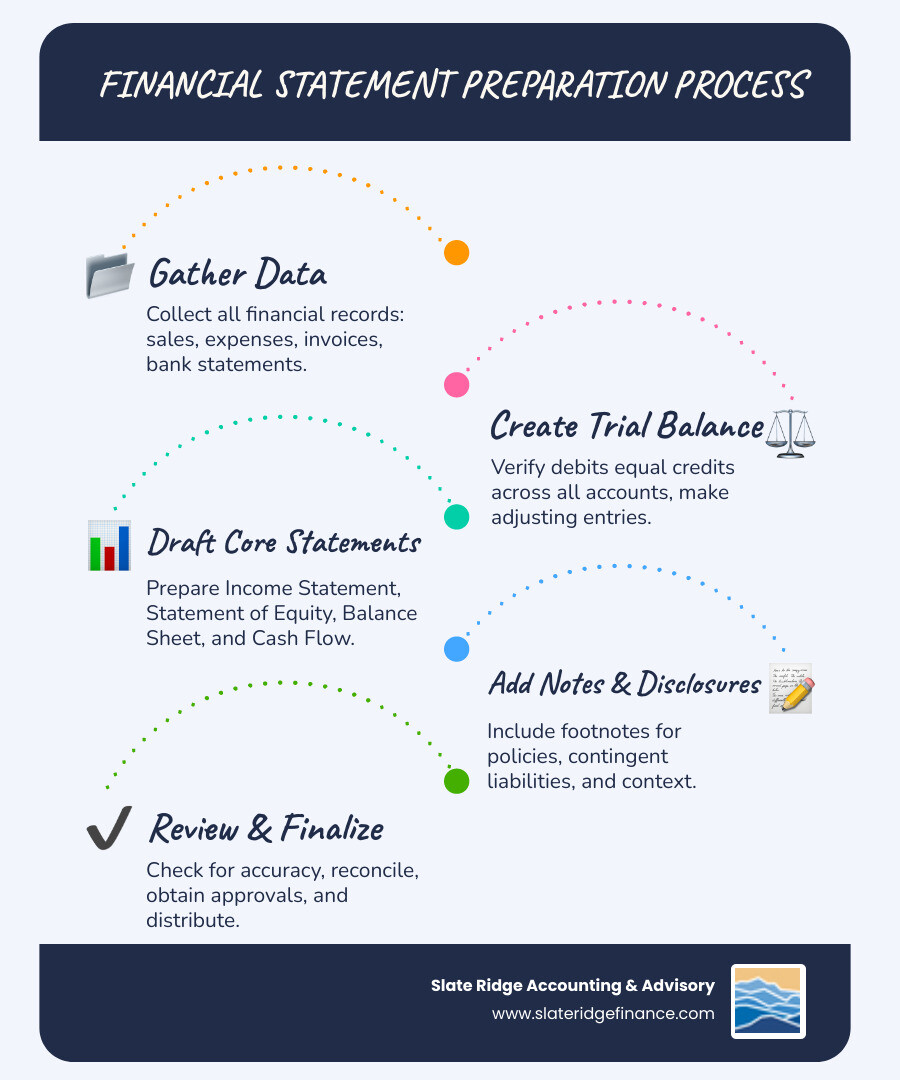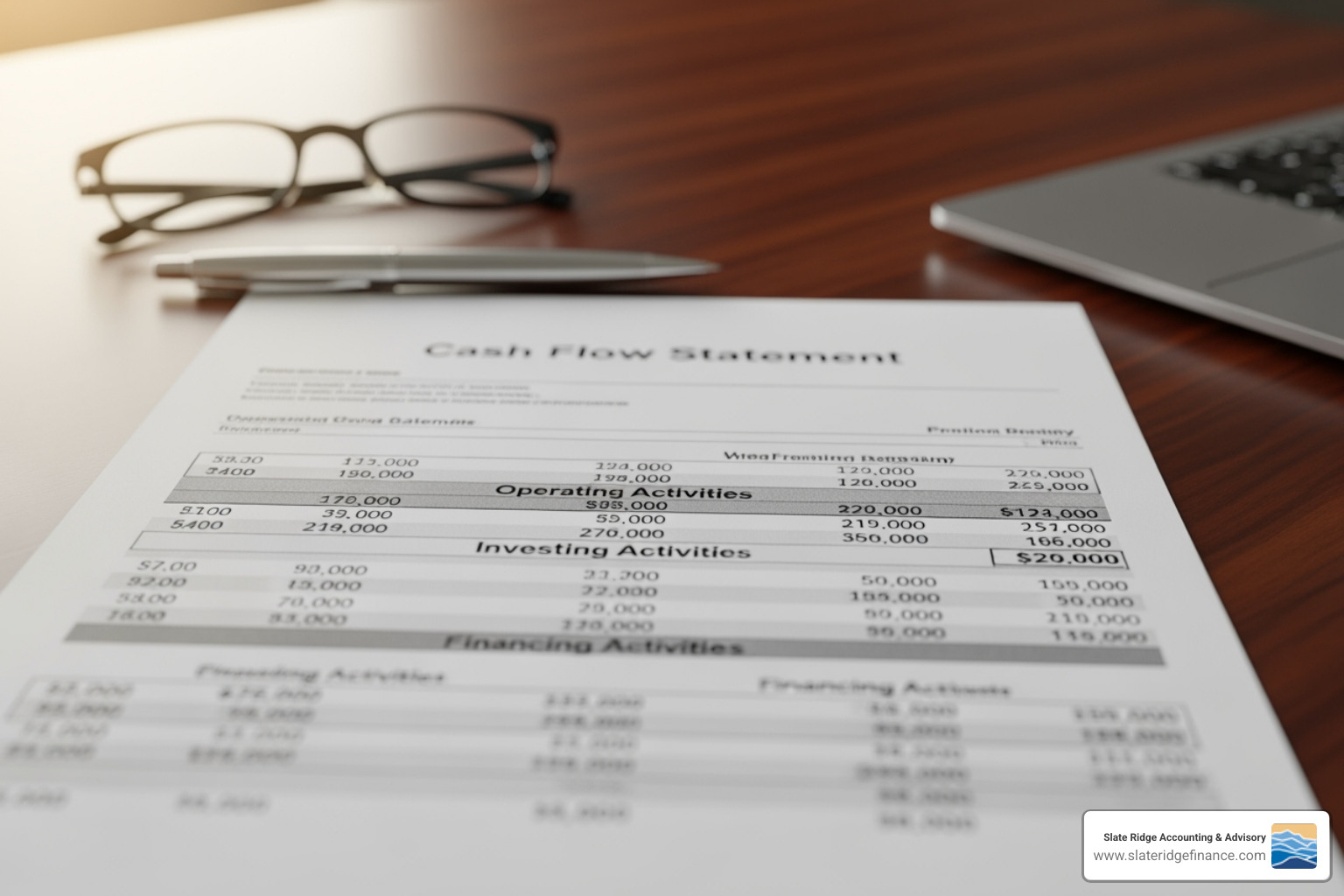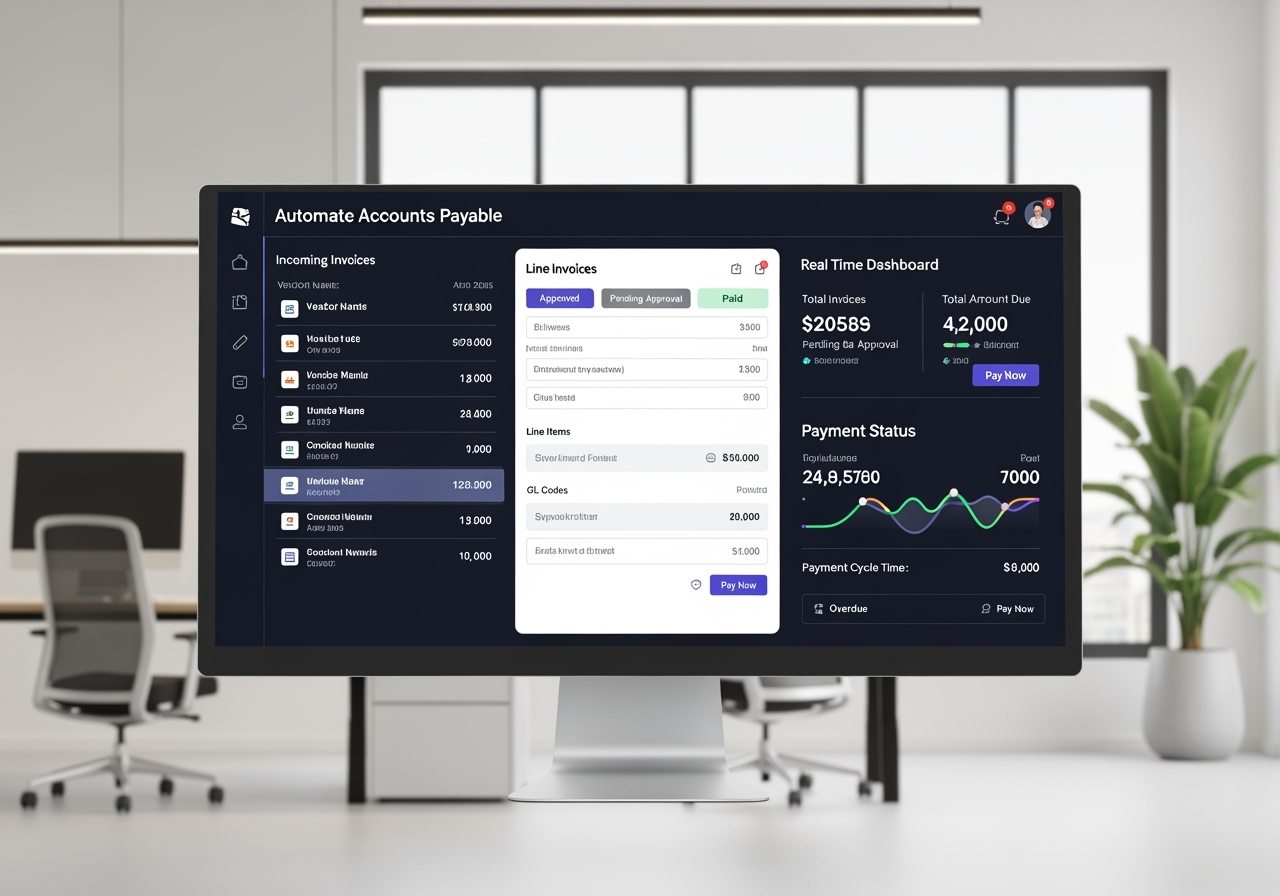Why Financial Statement Preparation is Your Business Lifeline
Financial statement preparation is like getting a comprehensive health checkup for your business. These formal records of your company's financial activities and performance are the foundation for every major business decision you'll make.
Here's what financial statement preparation involves:
- Gather all financial data - sales records, expenses, bank statements, receipts
- Create a trial balance - ensure debits equal credits across all accounts
- Make adjusting entries - record accruals, deferrals, and depreciation
- Prepare the four core statements in order:
- Income Statement (profit and loss)
- Statement of Shareholders' Equity
- Balance Sheet (assets, liabilities, equity)
- Cash Flow Statement (cash in and out)
- Add notes and disclosures - provide context and explanations
- Review and finalize - check for accuracy before distribution
As one accounting expert puts it: "Preparing financial statements is the most important step in the accounting cycle because it represents the purpose of financial accounting."
Without accurate financial statements, you're flying blind. You can't track profitability, plan for growth, secure loans, or make informed decisions about your business future. For companies with gross annual revenue under $100,000, you need at minimum a Balance Sheet and Income Statement. Larger businesses require more comprehensive reporting.
The good news? While the process seems complex, breaking it into clear steps makes it manageable - even for busy small business owners who'd rather focus on running their business than wrestling with spreadsheets.

Simple guide to Financial statement preparation:
Understanding the Core Financial Statements
Think of financial statement preparation as creating four different windows into your business – each showing you something unique but essential. These core statements work together like pieces of a puzzle, giving you the complete picture of your company's financial health.
Let's walk through each one and see how they tell your business story.
The Balance Sheet: Your Financial Snapshot
Your balance sheet is like taking a photograph of everything your business owns and owes at a specific moment in time. It's built on the fundamental accounting equation: Assets = Liabilities + Equity. This equation always balances (hence the name), which is why accountants get excited when everything adds up perfectly.

Assets are everything your company owns that has value. Current assets include cash, accounts receivable (money customers owe you), and inventory – basically anything you can turn into cash within a year. Non-current assets are your long-term investments like buildings, equipment, and that fancy espresso machine you bought for the office.
Liabilities represent what you owe to others. Current liabilities are bills due within a year – think accounts payable to suppliers or that short-term loan from your bank. Long-term liabilities are bigger commitments like your mortgage or equipment financing that stretches beyond a year.
Shareholders' equity is what's left for the owners after paying all debts. It's like the difference between your house's value and what you still owe on the mortgage – that's your equity.
This snapshot helps you understand whether you can pay your bills (liquidity) and handle long-term commitments (solvency). The Beginners' Guide to Financial Statements offers additional insights into reading these reports effectively.
The Income Statement: Measuring Profitability
While your balance sheet is a snapshot, your income statement is more like a movie showing your business performance over time – whether that's a month, quarter, or year. This is where you find the answer to the most important question: "Did we make money?"
The story starts with revenue – all the money flowing in from your main business activities. Then comes cost of goods sold (COGS) – the direct costs of creating whatever you sell. Subtract COGS from revenue and you get gross profit, which shows how much you make before considering all your other business expenses.
Operating expenses include everything else it takes to run your business – rent, salaries, marketing, that monthly software subscription. When you subtract these from gross profit, you get operating income, which reveals how well your core business performs.
Finally, after accounting for interest payments and taxes, you arrive at net income – the famous "bottom line." This number tells you whether your business truly made money during the reporting period.
The Cash Flow Statement: Tracking Your Cash
Here's something that surprises many business owners: you can be profitable on paper but still run out of cash. That's why the cash flow statement matters so much – it tracks every dollar that actually moves in and out of your business.

Operating activities show cash from your day-to-day business operations – collecting from customers, paying suppliers, covering payroll. This section reveals whether your core business generates positive cash flow.
Investing activities track cash spent on or received from long-term assets. Bought new equipment? That's an investing outflow. Sold an old delivery truck? That's an investing inflow.
Financing activities cover cash movements related to how you fund your business – taking out loans, paying them back, bringing in investors, or paying dividends.
You can prepare this statement using the direct method (showing actual cash receipts and payments) or the indirect method (starting with net income and adjusting for non-cash items). Most businesses use the indirect method because it's simpler and requires less detailed tracking.
Understanding your cash flow helps you assess liquidity – your ability to pay bills when they're due. It's the difference between theoretical profit and real money in the bank.
The Statement of Shareholders' Equity
This statement might seem like the quiet member of the family, but it plays a crucial role by showing how the owners' stake in your business changed over time. It's the bridge connecting your income statement to your balance sheet.
Retained earnings track the cumulative profits you've kept in the business rather than distributing to owners. When your income statement shows net income, that flows directly into retained earnings here. Common stock reflects any new shares issued or bought back. Dividends show distributions made to shareholders from those retained earnings.
This statement helps everyone understand whether your business is growing its equity through profitable operations, new investments, or both. It's particularly important when you're seeking investors or planning for future growth.
A Step-by-Step Guide to Financial Statement Preparation
Think of financial statement preparation like following a recipe for your favorite dish. You need the right ingredients, proper timing, and careful attention to detail to create something truly valuable for your business.
The beauty of this process lies in its logical flow – each step builds naturally on the previous one, creating a comprehensive picture of your company's financial health.
Step 1: Gather and Organize Financial Data
Before you can tell your business's financial story, you need to collect all the pieces of that story. This means gathering every scrap of financial information from your daily operations.
Transaction records form the foundation of everything that follows. You'll need sales invoices showing what you've sold and who owes you money, along with receipts for every business expense – from that morning coffee for a client meeting to major equipment purchases.
Your bank statements provide the official record of cash moving in and out of your business, while expense reports capture employee spending that might otherwise slip through the cracks.
Once you've gathered this mountain of financial data, it needs a home. This is where your chart of accounts comes in – think of it as your filing system that categorizes every type of transaction your business makes. All this information flows into your general ledger, which becomes the master record of your company's financial activity.
Many small business owners find this step overwhelming, and honestly, that's completely normal. If you're drowning in receipts and invoices, our team understands exactly how you feel. You can learn More info about our Bookkeeping Services for Small Business to keep your financial data organized and ready for statement preparation.
Step 2: Create and Adjust the Trial Balance
Now comes the moment of truth – creating your unadjusted trial balance. This document lists every account from your general ledger along with its balance, organized into debits and credits.
Here's the magic rule that must always hold true: debits equal credits. If they don't match, you've got some detective work ahead of you. Don't worry though – even experienced bookkeepers sometimes need to hunt down that stubborn missing penny.
But here's where it gets interesting. Your unadjusted trial balance tells only part of the story because business doesn't happen in neat daily chunks. Some expenses build up over time, like that utility bill that hasn't arrived yet. Some payments cover future periods, like insurance you've prepaid.
This is where adjusting entries save the day. These entries ensure your financial statements reflect what actually happened during your reporting period, not just when cash changed hands.
Accruals capture money you've earned but haven't collected yet, or expenses you owe but haven't paid. Deferrals spread prepaid expenses or advance payments from customers across the periods they actually cover. And depreciation recognizes that your equipment and assets lose value over time.
After making these adjustments, you'll have your adjusted trial balance – the clean, accurate foundation for building your financial statements.
Step 3: Draft the Financial Statements
This is where all your hard work pays off. With your adjusted trial balance ready, you can now create your financial statements. But order matters here because each statement feeds information into the next.
First comes the Income Statement. You'll transfer all your revenue and expense accounts from the adjusted trial balance to show whether your business made or lost money during the period. The net income (or loss) from this statement becomes crucial for the next step.
Next is the Statement of Shareholders' Equity. This statement takes that net income figure and adds it to your beginning retained earnings, then subtracts any dividends you paid out. The ending retained earnings balance flows directly to your balance sheet.
The Balance Sheet comes third. Here you'll list all your assets, liabilities, and equity accounts from the adjusted trial balance. The grand finale is confirming that your accounting equation balances – assets must equal liabilities plus shareholders' equity.
Finally, the Cash Flow Statement wraps everything up by showing actual cash movements. This statement uses information from your income statement and balance sheet, plus additional transaction details, to explain where your cash came from and where it went.
This careful sequence ensures all your statements work together harmoniously, creating a complete financial picture that stakeholders can trust.
Step 4: Add Notes and Disclosures
Your financial statements are like a great book, but sometimes readers need a little more context to understand the full story. That's where footnotes come in – they're not boring legal text, but essential explanations that help people truly understand your numbers.
The full disclosure principle guides this process. If information could influence someone's decision about your business, it needs to be shared. These notes might explain your significant accounting policies – how you value inventory or calculate depreciation, for example.
Contingent liabilities deserve special attention. If you're facing a potential lawsuit or warranty claims, stakeholders need to know about these possibilities. Commitments like long-term lease agreements also belong in the footnotes, along with detailed breakdowns of major balance sheet items.
Don't forget about events that happened after your balance sheet date but before you finalized the statements. These subsequent events can significantly impact how people interpret your financial position.
Step 5: Review, Finalize, and Report
You're in the home stretch, but this final step might be the most important. Internal review means carefully checking every number, every calculation, and every connection between statements. Think of it as proofreading the most important document your business will produce.
Reconciliation ensures everything ties together properly. Your cash balance should match your bank statement, your accounts receivable should tie to your customer records, and all your statements should tell a consistent story.
For businesses with gross annual revenue under $100,000, you'll need at minimum a Balance Sheet and Income Statement. But here's a crucial requirement – you need board approval. This isn't just bureaucracy; it's your board taking responsibility for the accuracy of these statements.
Management sign-off can happen through a signature from your Chair or Treasurer directly on the statements, a formal board resolution in your meeting minutes, or a signed letter from the board. Once you have this approval, your statements are ready for distribution to investors, lenders, or anyone else who needs to understand your business's financial health.
The entire process transforms raw transaction data into powerful tools for decision-making, and that change is what makes financial statement preparation so valuable for your business growth.
Streamlining the Process: Tools and Professional Help
Let's face it – financial statement preparation doesn't have to feel like climbing Mount Everest in flip-flops. The good news is that we're living in an amazing time where smart technology and expert guidance can transform this complex process into something far more manageable.
The Role of Software in Financial Statement Preparation
Remember the days when accounting meant drowning in paper ledgers and praying your calculator batteries wouldn't die mid-calculation? Those days are long gone, and frankly, we're not missing them one bit.
Modern accounting software has completely changed the game. These platforms bring automation to tasks that used to eat up entire weekends – things like data entry, transaction categorization, and bank reconciliation now happen almost magically in the background.
What's even better is real-time data access. Instead of waiting until month-end to find you're hemorrhaging cash or that your best customer still hasn't paid, cloud-based platforms give you instant insights into your financial health. It's like having a financial dashboard that never sleeps.
The biggest relief? Minimizing manual errors. We've all been there – one misplaced decimal point that throws everything off balance. Automated calculations and built-in error checks catch these mistakes before they become headaches. Plus, integrated KPI tracking means you can spot trends and opportunities without building complex spreadsheets from scratch.
When it comes time to actually create your statements, these systems can generate professional-looking reports with just a few clicks. No more formatting nightmares or wondering if your numbers look credible to stakeholders.
At Slate Ridge Accounting & Advisory, we harness these powerful tools to keep your financial data current and accurate around the clock. If you're curious about how modern accounting can transform your business operations, check out More info about Accounts for Small Business.
When to Call in a Professional
While software is incredibly powerful, there are times when you need a human brain – preferably one that speaks fluent accounting. Knowing when to bring in professional help isn't admitting defeat; it's making a smart business decision.
Complex transactions are often the first red flag. When you're dealing with mergers, acquisitions, major asset sales, or tricky revenue recognition scenarios, you want someone who's steerd these waters before. These situations have nuances that even the smartest software might miss.
Ensuring compliance is another big reason to seek expert help. Accounting standards like GAAP and IFRS seem to change as often as social media algorithms, and keeping up with every update while running your business is nearly impossible. Tax regulations add another layer of complexity that can make your head spin.
If your business is growing and heading toward audit preparation, having professionals involved early can save you months of stress later. Auditors appreciate well-prepared statements, and the process goes much smoother when everything is properly documented from the start.
Beyond just crunching numbers, financial professionals provide strategic advice that can be game-changing. They can help you interpret what your statements really mean, spot trends you might miss, and forecast growth opportunities. Think of them as translators who turn your numbers into actionable business insights.
And let's be honest about time – your hours are better spent on what you do best, whether that's serving customers, developing products, or growing your team. Outsourcing financial statement preparation to experts frees you up to focus on your core business activities.
Our team combines modern cloud-based accounting with deep financial expertise to help small businesses track their most important metrics and plan for sustainable growth. When you're ready for strategic insights that go beyond basic bookkeeping, explore More info about our Financial Planning Services.
Beyond the Numbers: Analysis, Limitations, and Compliance
Your financial statement preparation is complete, but this is where the real magic happens. These documents aren't just compliance paperwork gathering dust in a filing cabinet – they're your business's crystal ball, revealing insights that can transform your decision-making and fuel your growth.
Using Your Statements for Business Analysis
Think of financial ratio analysis as your business health diagnostic tool. Just like a doctor uses various tests to assess your physical health, financial ratios help you understand what's really happening beneath the surface of your numbers.
Liquidity ratios tell you whether you can pay your bills when they come due. The current ratio (current assets divided by current liabilities) is like checking if you have enough money in your wallet for today's expenses. If you've got $3 in current assets for every $1 in current liabilities, you're sitting pretty comfortable.
Profitability ratios reveal how well you're turning revenue into actual profit. Your net profit margin shows how many cents of profit you keep from every dollar of sales. Meanwhile, return on equity tells your investors (even if that's just you!) how effectively you're using their money to generate returns.
Solvency ratios look at the bigger picture – can your business survive and thrive long-term? The debt-to-equity ratio is particularly telling. If you're carrying too much debt compared to equity, it might be time to reassess your financing strategy.
The real power comes from identifying trends over time. Are your margins improving each quarter? Is your debt load becoming more manageable? These patterns help you make data-driven decisions that can propel your business forward. For a deeper dive into these calculations, check out these key financial ratios.
Understanding the Limitations of Financial Statements
Here's the thing about financial statements – they're incredibly valuable, but they're not fortune tellers. Understanding their limitations helps you use them more effectively.
Historical data is like looking in your rearview mirror while driving. It shows you where you've been, but the road ahead might look completely different. Your stellar performance last quarter doesn't guarantee smooth sailing next quarter.
Non-financial information often matters just as much as the numbers. Your team's morale, your brand reputation, customer loyalty, and that brilliant new product idea brewing in your mind – none of these show up on your balance sheet, yet they could be your biggest assets.
Inflation impact can make comparing numbers tricky over time. That equipment you bought five years ago for $10,000 might cost $15,000 today, but your balance sheet still shows the historical cost.
Estimates and assumptions are baked into many of your numbers. How long will that computer last? What percentage of your customers won't pay their bills? These educated guesses affect your statements, but they're still guesses.
Comparability issues arise when you try to benchmark against other companies. Different accounting methods, reporting periods, and industry quirks can make apples-to-apples comparisons challenging.
Meeting Regulatory Requirements (e.g., IRS)
Beyond helping you run your business better, financial statement preparation often fulfills legal requirements. In the United States, the Internal Revenue Service (IRS) has specific expectations for corporate tax filings.
The IRS requires that your tax return accounting methods clearly reflect income. While tax accounting can differ from financial accounting, your statements, typically prepared using Generally Accepted Accounting Principles (GAAP), form the starting point for your tax return. Understanding these principles ensures your records are consistent and defensible.
When filing a corporate tax return (Form 1120), the IRS requires businesses to provide financial statement information. For example, corporations with total receipts and total assets of $250,000 or more must complete Schedule L (Balance Sheet per Books). They must also complete Schedule M-1 or Schedule M-3 to reconcile the net income on their books with the income reported on their tax return.
These schedules ensure transparency and help the IRS understand how your business arrived at its taxable income. Getting these filings right the first time saves you from costly amendments, potential penalties, and the stress of an audit.
At Slate Ridge Accounting & Advisory, we steer these regulatory waters daily, ensuring your statements meet all requirements while serving your business needs. It's one less thing for you to worry about, leaving you free to focus on what you do best – growing your business.
Ready to get started?
Book a free consultation today and let’s explore how Slate Ridge can support your business with expert accounting that’s accurate, timely, and built around your goals.






